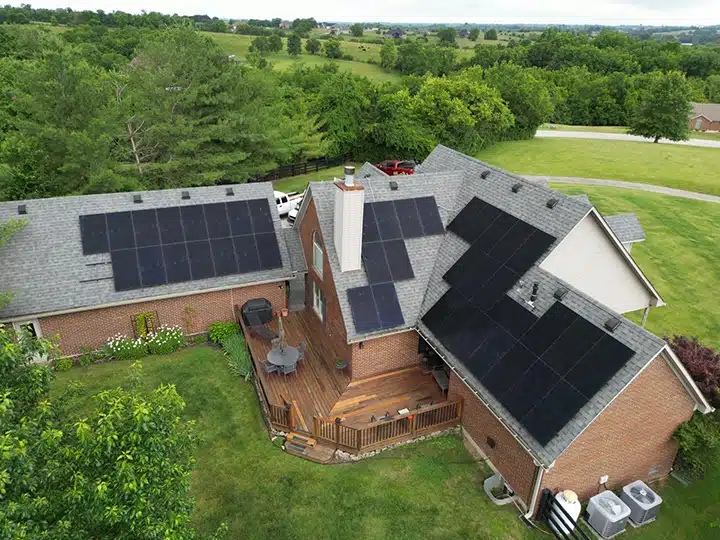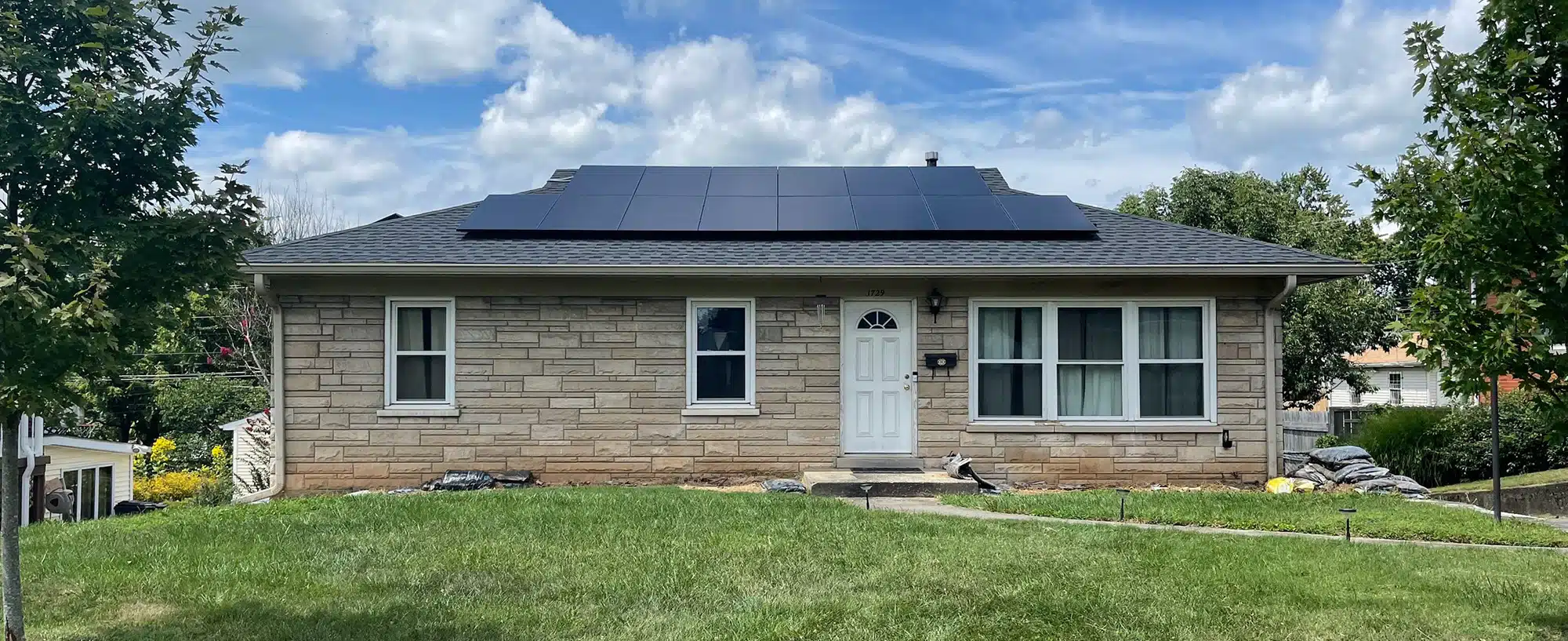Roofing
Serving the Bluegrass Region and Surrounding Areas
Solar Roofing Lexington, KY
Let’s talk about your roof! At Synergy Home, we look at everything holistically. Your roof is a major part of your home that is often ignored, and maybe even neglected. You see, the science of your roof and its relationship to your attic is an important part of the physics of your home, as well as its comfort and efficiency. It can even impact the health and safety of your home. Your roof, attic, and insulation should be evaluated at the same time. Let’s take a look at a traditional roof and attic setup and its problems. Then let’s discuss modern ways to improve upon it with roofing services in Lexington, KY, and nearby areas.
Schedule ServiceOur Energy Efficiency Services
The Traditional Roof and Attic
The traditional asphalt shingled roof has been around for over 100 years, and it has evolved very little in that time. While building science has evolved, builders and tradespeople are slow to adopt new ideas. Your roof and your attic work together to keep your home dry and ventilated, which gives you the often-quoted “a house needs to breathe” method. (keep reading to find out why this is NOT true!) For an attic to properly breathe, there is a simple equation of the square footage of the attic plus the height of the attic that will give you its total volume. We use that volume number to determine how many soffit vents are needed down low to allow air into the attic, and how many corresponding upper vents or ridge vents are needed to exhaust the attic heat. This natural ventilation process is based on a physics term called stack effect, and it’s the same way your fireplace exhausts smoke out the chimney.
In peak summer months, your attic can reach temperatures of over 140 degrees, making it a virtual oven sitting on top of your 72-degree living space. This becomes an additional challenge if your air-conditioning ductwork runs through the attic. Pushing cold air through ducts in a 140-degree oven is not very efficient, and you can even lose as much as 50% of the cooling that your system is putting out by the time the air gets back into the house. Attic ventilation is designed to keep these temperatures lower and reduce the greenhouse effect of an attic. Much like a chimney, the upper vents exhaust the heat from the attic, pulling in cooler outside air from the lower soffit vents. One of the flaws in this concept is on a 95-degree day you are trying to cool the attic with 95-degree air. While 95 is better than 140 degrees, it’s still not a very effective process. Especially because, in my experience, most builders and roofers do not put the proper amount of ventilation in the attic, or the attic insulation company sprays insulation over the soffit vents, which blocks them from allowing air flow from outside. For an attic to be properly ventilated, it takes three different trades working together who unfortunately never communicate with each other. The roof goes on early and the roofer decides how many vents or ridge vents are needed. The siding installers come next, and they decide how many soffit vents are needed.
Finally, at the end of the project, the insulation contractor comes in and adds insulation that often covers and blocks the soffit vents. To further complicate this issue, most builders choose the lowest bidder for all three trades, so corners are cut and the home suffers the consequences for years to come.
Some roofing contractors will install power attic fans, chef hats, or whirlybird fans to try to forcibly remove the air from the attic. This is a very bad process and many times the fans are overpowered or the soffit vents are blocked, this causes the power fans to suck air from inside your living space costing you the conditioned air you’ve already paid to cool. What’s worse, this sucked-out air from your house has to be replaced from somewhere, and in most cases, it’s coming from places you don’t want, such as leaks in the basement or crawlspace. This leads to dirty air, humidity, and potentially mold problems, and overall bad indoor air quality. Also, you often see these fans running in the middle of winter, drawing heat out of your attic at a time when you want to keep heat in your attic. I’ve seen power attic fans increase utility bills by as much as 30%. So something you added to help your house actually ends up creating a huge problem which over time will lead to many other issues. In summary, there is almost never a case when I would recommend attic fans.
Why People Pick Us

Fast and Flexible Service
We work around your schedule, delivering solutions that meet your needs ASAP.

Transparent Pricing
No surprises—just upfront, honest pricing you can rely on.

Licensed and Insured
Feel confident knowing every job is handled by certified professionals with your safety in mind.
The Modern Roof and Attic
Asphalt shingles are still the most practical roofing material in our area, but the relationship between the roof and ventilation has changed dramatically. Since the mid-1980s (can you believe that was 40 years ago?), the building science industry has recommended not venting an attic, but rather encapsulating the roof deck with sprayed-in foam insulation (the roof deck is the upper roof sheeting that the outside shingles are nailed to as opposed to the floor of the attic). This method improves upon the traditional method and corrects many of the issues we listed above. By moving the insulation from the floor to the roof of the attic, we are blocking the heat from ever getting in, keeping the attic much cooler, usually approximately only 10 degrees hotter than inside your home. This makes the air-conditioning system in the attic much more effective and efficient and lowers its run time by 30% or more. Not only does this result in immediate energy savings, but it also increases the life of the AC because it’s not living in such a harsh environment. Your AC will perform much better in an 85-degree attic than in a 140-degree attic. This also creates a semi-conditioned space for extra storage in the attic.
Encapsulating the attic also creates an air-sealed lid on the whole house. This keeps the heat you don’t want out in the summer, but also keeps the heat you do want in winter. It improves your home’s comfort and efficiency 12 months a year. By air sealing the attic, we are capping the whole house and stopping the negative effects of the “stack effect” we talked about in a traditional attic.
A house does NOT need to breathe! In fact, the tighter we can make a house, the better we can control the comfort and air quality inside of it. When a house breathes, we call it uncontrolled ventilation. When it does this, it pulls in dust and allergens from outside and often pulls insulation fibers from the attic and crawlspace. It’s not uncommon to test a sample of household dust and find it 50% fiberglass from the attic.
Roofing and insulation should be addressed at the same time. We can remove all the old venting when replacing the roof, allowing for a more complete encapsulation. This also makes for fewer roof penetrations and fewer chances of leaks down the road. We always want the least amount of holes in your roof. Removing all the roof vents also looks cleaner and more seamless for a more attractive house.
As evident from the above comparison between the traditional roof and attic setup versus the modern improvements, which type of house would you rather have? One using a hundred-year-old method that causes poor ventilation, dirty air, and inefficient HVAC? Or implementing the synergy of a new roof with a newly encapsulated, clean, cool, and efficient attic? Call Synergy Home today to schedule one of the least expensive home improvement projects you can do, providing comfort, efficiency, and indoor air quality to your home for years to come.
Maximize Your Home’s Efficiency with Solar Panels in Lexington, KY
Adding solar panels to your roof is one of the best ways to boost your home’s efficiency and reduce energy costs. By harnessing the power of the sun, Lexington solar panels provide clean, renewable energy to power your home while lowering your reliance on traditional utility services.
Not only can this lead to significant savings on your energy bills, but it also helps reduce your carbon footprint. Solar panels in Lexington work seamlessly with your home’s systems, and when paired with energy-efficient practices and tools like solar batteries, they ensure your home is running at peak efficiency all year long. Synergy Home can guide you through every step of the process, making it easy to enjoy the many benefits of solar energy solutions in Lexington, KY.
Schedule ServiceImprove Your Roof in Lexington, KY Today
Whether you have an old roof that needs to be replaced or you’re trying to make your roof more efficient, we have the solutions you need at Synergy Home. Call us today and we’ll get out to you fast to implement the solutions you need ASAP.
Call (859) 687-0553





